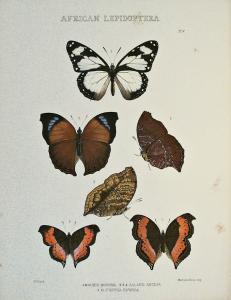African Lepidoptera, being descriptions of new species.
Eur 1,500 / USD 1,700
The price shown on each item does not include V.A.T (Value Added Tax). As a result of the recent EU legislation we are required to charge our EU customers the percentage of V.A.T. charged by the customer’s country of residence, unless they possess a V.A.T. registration number. Postage Additional.
London, Longmans, Green & Co. (1873-1875 ?). 3 parts. 4to. pp. 16, with 18 (12 handcoloured) plates. Unbound in original printed wrappers.
my copy is an unicum as it includes a third part quite unknown till today
Junk describes the work in his JUNK RARA II pp. 136 as follows: "Part 1 (February 1873). Coloured plates 1-6 (37 figures) with letterpress, pages 1-8. Contents: Papilio constantinus, evombar. Pieris manahari, antsianaka, cebron, capricornus, rhodanus. Eronia vohemara, verulanus. Amauris nossima. Salamis anteva. Junoniakowara. Acraea satis, pentapolis, peneleos, polydestes, pharsalus. Part 2 (Sept. 1874). Coloured plates 7-12 (41 figures) with letterpress, page 9-16. Contents: Acraea manadaza, masamba, masonala, hova. Godartia crossleyi, trajanus, Neptis biafra. Euryphene camarensis, ribensis, comus, nivaria, porphirion. Harma capella, cyclades, ciceronis. Mycalesis vola, ankova, iboina, antahala. Part 3 (1875 ?). Black plates 13-18 (35 figures) without letterpress. Contents: Papilio colonna, philonoë, andronicus, Acraea cydonis, sambavae, rabbaiea, satis. Godartia wakefieldii. Diadema usambara. Charaxes hadnanus, andara, andriba, analeva, andranadorus. Mycalesis avelona, Erebia rakoto, ankaratra, passandava, n.sp.? Part 1 and 2 contain figures and descriptions of new species chiefly from Madagascar, then from the Camaroons, Old Calabar and Ribé (East Africa). The descriptions are copied (literally) from Ward's 2 papers (published in 'Entomologist's Monthly Magazine' volumes 6-9 and 8-9): 'Descriptions of new species of Diurnal Lepidopt. From Madagascar'. and 'Descriptions of new species of African Diurnal Lepidoptera'. The second paper is continued also through volume 10 of the 'E.E.M.' and I have no doubt that the species described in the continuation are those figured there in the 3rd part, which has no letterpress. This very beautiful work is highly important for the knowledge of the East African Fauna, as it contains 55 new species. Ward has not written any other work and also the "A.L." were - perhaps owing to the death of the author - soon interrupted. The book may be considered as the rarest of all modern works on Butterflies. My copy is the first I have ever seen, though I have searched for the book for more than 20 years. But, what is the chief thing: my copy is an unicum as it includes a third part quite unknown till today, which, as it seems, had never been in the trade; for neither are the plates coloured nor has it a letterpress, and the numbers of the plates as well as the name of the butterflies are not printed but only neatly written by pencil". We presume that Junk was wrong when he thought his copy to be an unicum, as we have sold a few copies in recent years.




